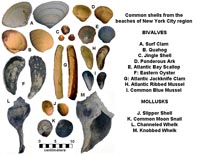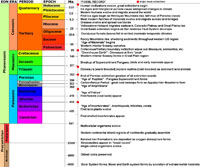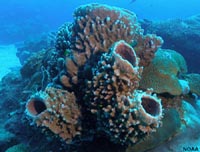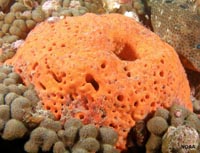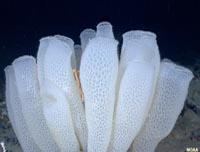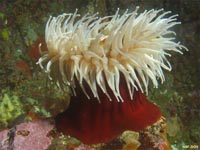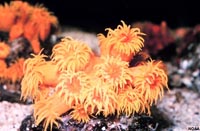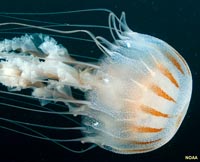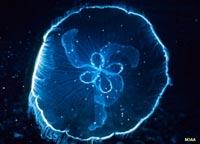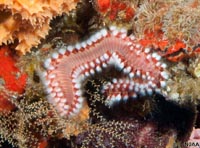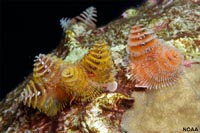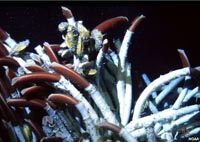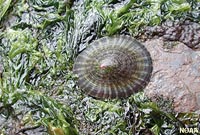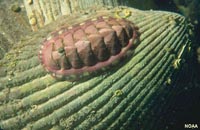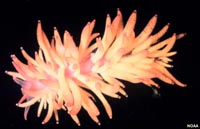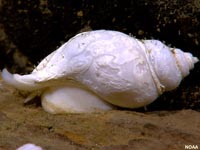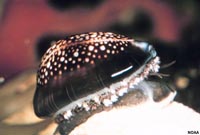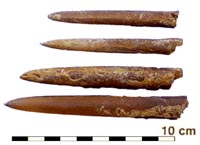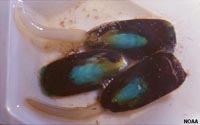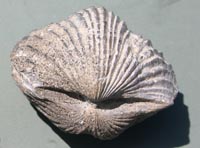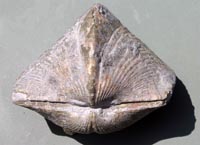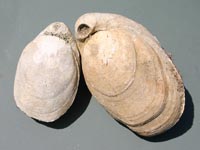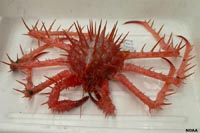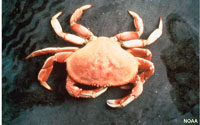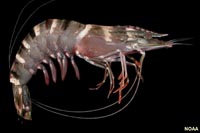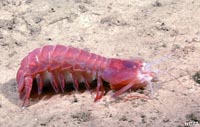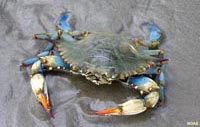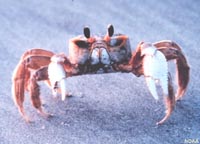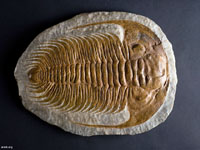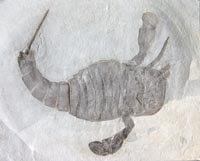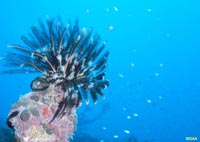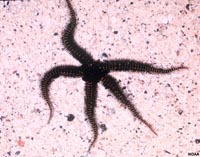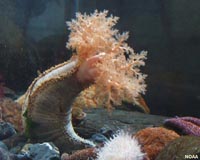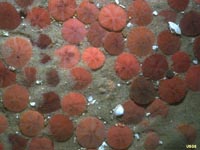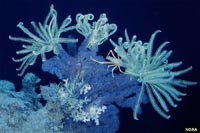
Oceanography 101 |
Return to class home page |
Chapter 15 - Marine Communities in Benthic Environments |
This chapter focuses on animals that are grouped as lower-level organisms in the benthic environment, specifically invertebrates —most of which are benthic animals that live attached on the seafloor or live near the seabed in the open ocean or coastal marine environments. The next Chapter 16 focuses on vertebrates and life in the pelagic environment.
Review: General classifications of Living ThingsTaxonomy is the system of classifying and naming organisms (reviewed in Chapter 2). Carolus Linnaeus was first to development of a hierarchical system of classification of nature (biological organisms, present and past) .Today, this system includes seven taxa: kingdom, phylum, class, order, family, genus, and species. (These are constantly being split into additional taxa levels as discoveries are made. Look at the example of humans.
|
Click on thumbnail images for a larger view. | ||||||||||||||||||||||||||||||||||||||||||||||||||||||||||||||||
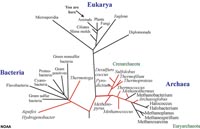 Fig. 16-1. Bioscientists are constantly reclassifying life forms as discoveries and new information becomes available. The term domain has been added to apply to super kingdoms subdivision status based largely on modern discoveries in microbiology - still under debate!This figure shows one of the more complex diagrams showing all the current know domains and lineages of life forms on Earth. |
|||||||||||||||||||||||||||||||||||||||||||||||||||||||||||||||||
Kingdoms of Life
|
Marine Animals in Benthic Environments |
ProtozoaProtozoans are single-celled animals (microbes). In the ocean environment they have the role of primary consumers in the food chain (they are zooplankton).Protozoa are a diverse group of unicellular eukaryotic organisms. Historically, protozoa have been defined as single-celled organisms with animal-like behaviors, including motility (able to move) and predation. Protozoan that are major contributors to the food chain and to marine sediments include foraminifera and radiolarians. |
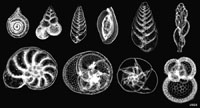 Fig. 15-3. Many foraminifera have calcareous skeletons that accumulate as calcareous sediment. |
 Fig. 15-4. Radiolarians have siliceous tests that accumulate as siliceous sediment. |
PoriferaPoriferans are “sponges.” They are among the oldest known animal fossils, dating from the Late Precambrian. The fossil record exceeds 900 genera. There are about 5,000 living sponge species in three distinct groups: Demospongia (soft sponges), Hexactinellida (glass sponges), and Calcarea (calcareous sponges). Sponges are filter feeders. Sponges have tiny pores in their outer walls through which water is drawn in. Cells within sponge walls filter plankton from the water pumped through the body and out other larger openings. |
CoelenteradaCoelenterates include jellyfishes, sea anemones, corals, and hydra. They are among the most ancient multicellular organisms, appearing in Late Precambrian time. All coelenterates are aquatic, mostly marine. Coelenterates are animals that have very simple tissue organization, with only two layers of cells, external and internal. They are characterized by a single hollow internal cavity serving for digestion, excretion, and other functions and having tentacles on the oral end. radially symmetrical body arrangement. Coelenterates have a network of nerves is spread throughout the body. Many forms exhibit polymorphism, where individuals with different body arrangements are present in a colony for different functions. Coelenterates generally reproduce asexually by budding, though sexual reproduction does occur in some groups. |
AnnelidaThe annelids also known as segmented worms, are a large phylum, with over 17,000 species. They have soft bodies with no legs or hard skeleton. Annelid bodies are divided into many little ring-like segments. There are many other kinds of worms, but only annelids are segmented this way. Most marine species are polychaetes (two mostly terrestrial groups are earthworms and leaches). Annelids have bilaterally symmetrical, triploblastic (having three layers of flesh--ectoderm, mesoderm, and endoderm),; they have an internal body cavity with a mouth and anus), invertebrate organisms. They also have parapodia used for locomotion. Many species can reproduce sexually and asexually. Polychaetes produce planktonic larvae. Because they are soft-bodied, fossils are rare. Annelids are known from the Cambrian Period. |
MolluscaMollusca (or mollusks) are a very diverse groups of animal with at about 85,000 living species. Mollusks are the largest marine phylum, comprising about 23% of all known marine organisms. Mollusks include clams, scallops, oysters, mussels, limpets, chitons, and snails (snails are gastropods—the account for about 80% of invertebrate species). Cephalopods are mollusks and include octopuses, squid, cuttlefish, and nautilus. • Mollusks all have unsegmented soft bodies with a "head" and a "foot" region (they may not look like a head or foot!). |
|||||||||||||||||||||||||||||||||||||
|
|||||||||||||||||||||||||||||||||||||
BrachiopodaBrachiopods are marine animals that have hard valves (shells) on the upper and lower surfaces (different than bivalve mollusks that have a left and right shell arrangement). Brachiopod valves are hinged at the rear end so that the front can be opened for feeding or closed for protection. Brachiopod have a stalk-like pedicle that projects from an opening in one of the valves that attaches the animal to the seabed. Brachiopods appeared in the early Cambrian, and diversified in stages throughout the Paleozoic Era. One group, Lingula, has been around since the Early Cambrian (Figure 15-37). At their peak the brachiopods were among the most abundant filter-feeding and reef-building groups of organism, but their significance diminished after the great extinction at the end of the Permian Period. |
ArthropodaArthropods include insects, arachnids (spiders), myriapods (millipedes, centipedes), and crustaceans (lobsters, crabs, shrimp, and barnacles).Only crustaceans are abundant in the marine environment. Arthropods have an exoskeleton (external skeleton), a segmented body, and jointed appendages (limbs) and cuticle made of chitin, often mineralized with calcium carbonate. The exoskeletons inhibits growth, so arthropods replace their rigid cuticle periodically by molting. Most species have compound eyes. Arthropods appeared in the Cambrian period with trilobites a dominant group throughout the early Paleozoic Era. Eurypterids (sea scorpions) grew to over a meter in length in the Silurian Period. Most Paleozoic forms vanished at in the end of the Permian extinction event, but they have since successfully diversified into inhabit nearly all of Earth’s environmental settings. All insects are arthropods, but not all arthropods are insects. Amazingly, biologists estimate there may be between 6 to 10 million species of insects, but there are none known that live in the marine environment. |
||||||||||||||||||||||||||||
|
||||||||||||||||||||||||||||
EchinodermataEchinoderms are marine animals recognizable by their (usually five-point) radial symmetry. Echinoderms include starfish, sea urchins, sand dollars, and sea cucumbers, and crinoids (sea lilies). Echinoderms are found at every ocean depth. The phylum contains about 7000 living species. There are no known freshwater or terrestrial species. They are one of the groups of organisms that successful proliferate in the deep-sea environment.Crinoids have “flower-like” crowns that filter plankton. The crowns are connected to stocks attached to the solid sea floor (making them “sessile” organisms). Other echinoderms are mobile, capable of moving to avoid prey, seek prey, or adapt to changing conditions on the seafloor. Most echinoderms appear to have a “five sided” or pentagonal or star-shaped appearance (it is really bilateral symmetry). Sand dollars and sea biscuits have small spicules similar to sea urchin spines. They use them to move and to work food toward their mouth-like openings. Echinoderms first appear in abundance in the early Paleozoic Era. Echinoderms have ossified skeletons (composed of calcium carbonate), and contributed massive amounts of biogenous sediments to many of the world's ancient massive limestone deposits. |
Benthic Communities |
Rocky Intertidal ZonationSpecies are either:• Attached to bottom (e.g., anemones, corals) • Move over seafloor (e.g., crabs, snails) Rocky shores subdivisions include:
|
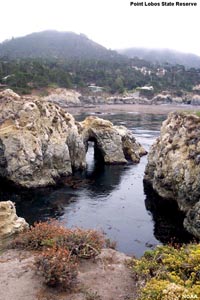 Fig. 15-61. Rocky shore tide pool (Point Lobos, CA). |
Communities on Sandy Beach Shores* Sandy Beach Intertidal Zone• No stable, fixed surface • Burrowing provides more stable environment • Less risk of temperature extremes and drying out Burrowing invertebrates include: Mollusks - Soft body, hard shell (most, not all) including clams and mussels Worms (annelids) Sand Crabs |
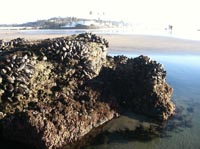 Fig. 15-62. Mussels on an isolated rock on a sandy beach. |
Communities on Sandy Beach Shores* Sandy Beach Intertidal Zone• No stable, fixed surface • Burrowing provides more stable environment • Less risk of temperature extremes and drying out Burrowing invertebrates include: Mollusks (with a soft body, hard shell—most, not all) (clams and mussels most common); Worms (annelids) and Sand Crabs. |
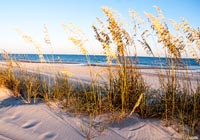 Fig. 15-63. Most sandy beaches appear deceivingly barren of marine life. |
Shallow Offshore Benthic CommunitiesShallow offshore benthic communities include:• offshore sand bars (mostly inhabited by burrowing organisms) • rocky bottoms (host many attached organisms) • coralline reefs (complex, self-constructing communities). Shallow offshore benthic communities are described as rich ecosystems because of the diversity and abundance of organisms in some of these environmental settings. |
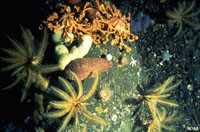 Fig. 15-64. Northern Europe rocky bottom community |
Kelp and Kelp ForestsKelp attaches to rocky bottoms.Kelp grow up to 0.6 meters (2 feet) per day—one of the world's fastest growing species. Kelp can live as solitary plants to forests several miles long. Individual plants can grow up to 175 long. Kelp provides shelter for other organisms. |
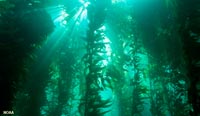 Fig. 15-65. Kelp "forest" |
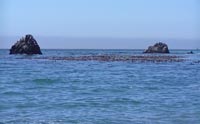 Fig. 15-65. Offshore kelp bed along the California coast. |
Coral ReefsCoral reefs are located in tropical settings.• Reefs require warm, clear, and shallow water. • Reefs also provide sediments and food to deeper water settings. Corals are animals (or communities of animals) consisting of polyps – each polyp is an individual coral animals. Corals produce calcium carbonate skeletal structures. Other reef-forming animals include coralline algae (plants), bryozoans, sponges, mollusks, and many others. Animals feeding on reef-forming organisms produce large quantities of sediment (building up reefs). |
 Fig. 15-66. Coral reef |
Importance of Coral ReefsReefs are the largest structures created by living organisms.• The Great Barrier Reef in Australia is more than 1250 miles (2,000 km) long and many miles wide. • Coral reefs are found in the Florida Keys, Bahamas, many coastal Caribbean destinations. The land itself in these regions consist of ancient coral reef deposits. • Atolls throughout the South Pacific and Indian Oceans are surrounded by coral reefs. • Coastlines of Red Sea, Persian Gulf, and Africa are lined with coral reefs. Coral reefs have great diversity of species. Reefs protect shorelines from storm erosion and protect inland freshwater supplies. Coral Reefs are in decline: 30% are healthy today, 41% were healthy in 2000. Threats to coral reefs: • Hurricanes • Floods • Coral bleaching • Human encroachment and exploitation. |
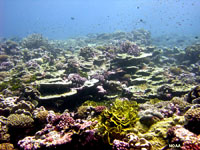 Fig. 15-67. Atoll reef community 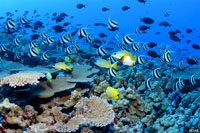 Fig. 15-68. Hawaiian reef community |
Deep-Ocean Floor Communities• The deep ocean is largely unexplored.• Light is completely absent below 3300 feet. • Temperature usually 28°F to 37°F. • A very high pressure environment. • Deep-ocean floor communities exist in oxygen depleted environments compared to the surface environment. |
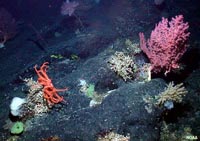 Fig. 15-69. Deep-sea community |
Hydrothermal VentsHydrothermal vent communities on the deep sea have an abundance of “unusual” life forms (unlike anything in coastal environments).Life around deep-sea vents are supported by chemosynthesis (primary production not supported by photosynthesis). Microscopic organisms (base of local food chain) thrive on hydrogen sulfide from vents. Microbes manufacture sugar, carbon dioxide, and dissolved oxygen. Hydrothermal vent species (secondary consumers and decomposers) include: • Giant tubeworms • Giant clams • Giant mussels • Crabs. Hydrothermal vents may active for years or decades. Animals species are similar at widely separated vents. Larvae from vent communities drift from site to site. |
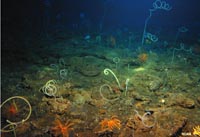 Fig. 15-70. Hydrothermal vent community. |
| Chapter 15 quiz questions |
